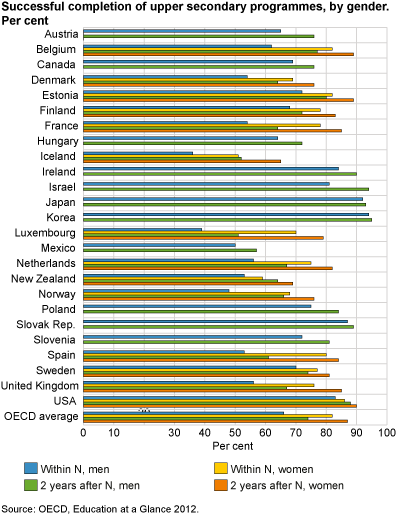Indicators on education in the OECD, academic year 2009/2010
More women than men complete on time
Published:
As an average for OECD countries, 70 per cent of boys and girls who start upper secondary education complete the programmes they entered within the theoretical duration of the programme. In 28 out of 33 OECD countries, at least 60 per cent aged 25–64 have completed upper secondary education or higher.
- Series archive
- Indicators on education in the OECD
OECD’s publication Education at a Glance 2012 shows that 70 per cent – as an average for OECD countries – of the students who started their upper secondary education had successfully completed within the theoretical duration of the programme. As an OECD average, 74 per cent of the women and 66 per cent of the men completed. In all countries, women were more likely than men to complete upper secondary education within the stipulated time.

In Norway, 57 per cent of the students who started their upper secondary education in 2004 had successfully completed within the theoretical duration of the programme – 13 percentage points below the OECD average. Among the Nordic countries, only Iceland (44 per cent) had lower completion rates.
The OECD average hides the fact that the proportion of students who complete their education within the stipulated time varies considerably among countries. In Korea, 95 per cent of the students who started their upper secondary education had successfully completed within the theoretical duration of the programme. In Japan, there were as many as 93 per cent. The lowest completion rates are found in Iceland and Luxembourg, with 44 and 45 per cent respectively.
Giving students two extra years to complete the programmes has a very varied effect on the completion rates from upper secondary education in the different countries. As an average for all OECD countries, 85 per cent of students had successfully completed their upper secondary programmes two years after the stipulated time of graduation. In France, Spain and Luxembourg, the completion rates with an extra two years increased by more than 20 percentage points compared with the completion rates within the theoretical duration of the programme. In New Zealand and the USA, the increase was approximately 5 percentage points.
The large differences in upper secondary completion rates are linked to the duration of programmes, and also how accessible these programmes are. In some countries, it is also relatively common for student apprentices to take a break from their studies and leave the education system temporarily.
At a national level, Statistics Norway publishes more in-depth analyses of the throughput of pupils in upper secondary education in Norway.
More young women than men hold a tertiary degree – in almost all OECD countries
On average, three out of ten aged 25–64 in OECD countries had completed tertiary education in 2010. Among women, 32 per cent had attained a tertiary degree and the corresponding figure for men was 29 per cent. In Norway, 37 per cent had completed tertiary education – 41 per cent of the women and 34 per cent of the men.
In the age group 25–34, almost four out of ten had attained tertiary levels of education, and the gender difference is, on average, 10 percentage points in favour of women. Among women in this age group, 42 per cent had attained a tertiary education, compared to 33 per cent of men. In all OECD countries apart from Switzerland and Turkey, a greater proportion of women than men had attained tertiary education in 2010. In 19 out of 34 OECD countries, the gender gap is 10 percentage points or more in favour of women. In Norway, Israel and Slovenia, the gender gap is 17 percentage points, and in Estonia 48 per cent of the women had completed tertiary education compared to 28 per cent of the men – a difference of 20 percentage points.
Tables
Contact
-
Statistics Norway's Information Centre
